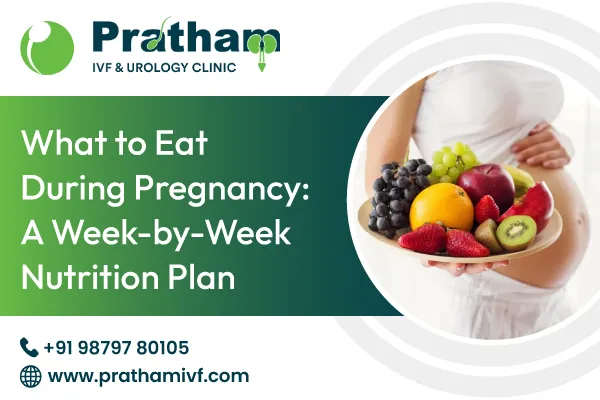
What you eat during pregnancy fuels two bodies: yours and your baby’s. A thoughtful diet supports steady energy, healthy weight gain, balanced blood sugar, strong immunity, and the building blocks your baby needs for organs, bones, brain, and blood. Good nutrition also helps ease common symptoms—nausea, constipation, heartburn—and lowers the risk of deficiencies that can affect fetal development. Early pregnancy changes quickly. Taking things one week at a time makes nutrition practical. Each week below focuses on a simple theme—one or two nutrients, a handful of easy foods, and small lifestyle tweaks—so you can build strong habits without feeling overwhelmed.
Goals of this plan
The primary goal of this plan is to support a healthy pregnancy by focusing on the “big five” essential nutrients: folate, iron, calcium, protein, and omega-3s. Meals are designed to remain realistic, affordable, and tasty so expecting mothers can enjoy food without added stress. Practical symptom-smart tips address common challenges like nausea, fatigue, and digestive discomfort, while gentle guidance on hydration, light movement, and mindful eating helps create balanced daily habits. Importantly, this plan is intended to complement—not replace—the advice and recommendations provided by your healthcare team, ensuring both mother and baby receive optimal care and nutrition.
Understanding Nutritional Needs in Pregnancy
Key nutrients for pregnant women:
- Folate (folic acid): Crucial for early brain and spinal cord development. Aim for 600 mcg DFE daily from foods + prenatal vitamin (which usually contains folic acid or methylfolate).
- Iron: Needed to make extra red blood cells for you and your baby. Targets increase to 27 mg/day. Pair iron foods with vitamin C to boost absorption.
- Calcium: Builds bones and teeth; supports muscles, nerves, and heart rhythm. Target ~1,000 mg/day (1,300 mg/day for teens).
- Protein: Builds tissue, hormones, enzymes, and antibodies. Aim for ~75–100 g/day depending on your weight and trimester (your clinician can personalize this).
- Omega-3 fatty acids (DHA/EPA): Support the fetal brain, eyes, and nervous system. Target 200–300 mg/day DHA from diet or supplements.
Caloric intake adjustments:
- First trimester: Most people do not need extra calories yet; focus on quality, not quantity.
- Second trimester: ~+340 calories/day (a yogurt and fruit, or nut butter toast).
- Third trimester: ~+450 calories/day (an extra balanced snack or small meal).
These are averages; your provider will tailor guidance to your body, activity, and health.
Week 1: Early Pregnancy Nutrition
In the earliest weeks, folate is non-negotiable. It helps form the neural tube, which becomes the brain and spinal cord.
- Leafy greens: spinach, kale, romaine, fenugreek leaves
- Legumes: lentils, black beans, chickpeas
- Fortified cereals/grains: check labels for folic acid
- Citrus & avocado: bonus vitamin C, fiber, and healthy fats
Spinach dal over brown rice, topped with lemon and a spoonful of plain yogurt. Begin a gentle routine: 6–8 glasses of water/day. If plain water is hard, try warm water with lemon, diluted fruit infusions, or coconut water (watch sugars).
Week 2: Building a Healthy Foundation
As blood volume starts rising, iron and protein support oxygen transport and tissue growth.
- Lean meats/fish: chicken, turkey, salmon, sardines
- Vegetarian options: tofu, tempeh, paneer, dals
- Nuts & seeds: almonds, pumpkin seeds, sesame, chia
- Eggs: complete protein, choline for brain development
Snack ideas for steady energy:
- Whole-grain toast + peanut butter + banana slices
- Roasted chickpeas + orange wedges (vitamin C boosts iron)
- Yogurt parfait with berries + crushed walnuts
Week 3: Managing Morning Sickness
Aim for bland, dry, cool, and protein-rich bites. Keep something by the bed and nibble before rising.
- Ginger: tea, chews, or grated in warm water
- Crackers, dry toast, khakhra: small, frequent bites
- Plain yogurt, cottage cheese, boiled eggs: gentle protein
- Cold smoothies: banana, yogurt, oats, a few spinach leaves
Sip every 10–15 minutes if queasy. Ice chips, ginger tea, or electrolyte sips may help. Seek care if you can’t keep fluids down or if signs of dehydration appear.
Week 4: Emphasizing Calcium and Vitamin D
Your baby is laying the foundations for bones and teeth. If calcium is low, your body pulls it from your bones—so focus on adequate intake.
- Dairy: milk, yogurt, cheese
- Fortified plant milks: soy, almond, oat (check labels)
- Leafy greens: bok choy, kale, amaranth leaves
- Sesame seeds & tofu (calcium-set)
A short period of safe sun exposure (as advised by your clinician and local UV guidance) plus fortified foods or a supplement helps you absorb calcium effectively.
Week 5: Incorporating Healthy Fats
DHA/EPA support brain, eye, and nervous system development; they also help maintain balanced inflammation and may support maternal mood.
- Fatty fish: salmon, sardines, mackerel (choose low-mercury options 1–2×/week)
- Vegetarian sources: walnuts, flaxseed meal, chia (ALA form; consider DHA algae oil if you don’t eat fish)
- Avocado & olive oil: heart-healthy fats for cooking and salads
Use healthy fats while keeping portions moderate. Pair fats with fiber and protein for steady energy and fullness.
Week 6: Focusing on Fiber
Fiber eases constipation (common in pregnancy), stabilizes blood sugar, and feeds a healthy gut microbiome.
- Whole grains: oats, brown rice, wheat roti, quinoa, millet
- Fruits & veg: berries, pears, apples, carrots, beetroot, okra
- Legumes: dals, beans, chickpeas
- Seeds: chia, flax, psyllium (as advised)
Go slow, hydrate well, and include movement (a short daily walk). Combine fiber with fluids and healthy fats for comfort.
Week 7: Preparing for the Second Trimester
Appetite often improves soon. Keep focusing on balanced meals, gentle snacks, and consistent hydration. If weight gain is a concern (too little or too much), ask your provider for tailored targets.
What a balanced plate looks like:
- ½ plate: colorful vegetables and fruit
- ¼ plate: whole grains or starchy veg
- ¼ plate: quality protein (animal or plant)
- + healthy fat: olive oil, nuts, seeds, avocado
Importance of prenatal vitamins: A prenatal complements your diet with folate, iron, iodine, vitamin D, B12 (especially if plant-based), and DHA (if included). Take as directed; let your clinician know about any side effects.
Smart Safety Notes (All Weeks)
- Foods to limit/avoid: high-mercury fish (shark, swordfish), raw/undercooked meat, runny eggs, unpasteurized dairy/juices, deli meats unless heated, high-sugar drinks, excessive caffeine (generally cap at ~200 mg/day, confirm with your provider), and alcohol.
- Food hygiene: wash produce well, cook proteins thoroughly, separate raw and cooked items, and refrigerate promptly.
- Allergies/intolerances: swap equivalents (e.g., fortified plant milks for dairy, tofu/beans for meat) to meet nutrient goals.
Simple Weekly Meal Builder (Mix & Match)
Breakfast:
- Oatmeal with chia, berries, and a spoon of nut butter
- Vegetable omelet + whole-grain toast + fruit
- Smoothie: yogurt/kefir, banana, spinach, oats, flax, cinnamon
Lunch:
- Lentil/bean bowl with brown rice, sautéed greens, salad
- Grilled salmon or tofu, quinoa, roasted vegetables
- Whole-grain wrap with hummus, paneer/chicken, crunchy veg
Snack:
- Apple + almonds
- Yogurt + crushed walnuts + honey drizzle
- Roasted chickpeas + citrus wedges
Dinner:
- Daal + millet roti + mixed veg + raita
- Stir-fried tofu/tempeh + veggies + soba noodles
- Baked fish + sweet potato + steamed greens
Hydration: Water, sparkling water with lemon, ginger tea, coconut water (moderation), buttermilk/chaas
Gentle Symptom Solutions
- Nausea: small, frequent meals; ginger; avoid greasy foods; try cold foods; vitamin B6 if recommended.
- Heartburn: smaller portions, avoid late meals, elevate head, choose baked over fried, limit spicy/acidic foods.
- Constipation: more fiber + fluids, daily walks, warm lemon water in the morning; discuss safe stool softeners if needed.
- Fatigue: steady protein + complex carbs; iron status check if persistent; consistent sleep routine.
Putting It All Together: Weeks 1–7 at a Glance
- Week 1: Folate first—leafy greens, legumes, fortified grains; hydrate
- Week 2: Iron + protein—lean meats or pulses, eggs, nuts/seeds
- Week 3: Nausea navigation—ginger, bland bites, frequent sips
- Week 4: Calcium + vitamin D—dairy or fortified plant milks, greens, safe sun
- Week 5: Healthy fats—DHA fish or algae oil, walnuts, flax/chia
- Week 6: Fiber focus—whole grains, fruit/veg, legumes; go slow + water
- Week 7: Balance the plate; keep prenatal vitamins consistent
Conclusion
A thoughtful pregnancy diet is about consistency, not perfection. Small, steady choices—folate early on, iron with vitamin C, calcium with vitamin D, omega-3s, enough protein, and plenty of fiber—create a strong foundation for you and your baby. Every pregnancy is unique. Medications, nausea, food preferences, and health conditions can change your needs. Share questions, symptoms, and concerns so your plan stays personal and practical.
For personalized, compassionate guidance on pregnancy nutrition and prenatal care, contact Pratham IVF Center – Call: +91 98797 80105, Mail: prathamivf@gmail.com.
 Ahmedabad Top Rated IVF Center
Ahmedabad Top Rated IVF Center




